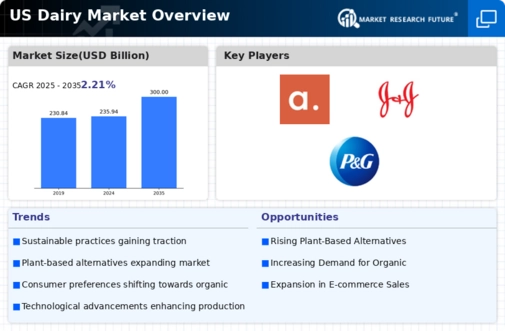Sustainability Initiatives
Sustainability has become a critical focus within the dairy market, as consumers increasingly prioritize environmentally friendly practices. Dairy producers are adopting sustainable farming methods, such as regenerative agriculture and reduced carbon footprints, to appeal to eco-conscious consumers. In 2025, it is estimated that 60% of consumers in the US are willing to pay a premium for sustainably sourced dairy products. This shift not only enhances brand loyalty but also aligns with regulatory pressures for reduced greenhouse gas emissions. As the dairy market embraces sustainability, it may lead to innovations in packaging and production processes, ultimately reshaping consumer perceptions and purchasing behaviors.
Rising Demand for Dairy Alternatives
The dairy market is experiencing a notable shift towards plant-based alternatives, driven by changing consumer preferences. As more individuals adopt vegan or lactose-free diets, the demand for non-dairy products such as almond milk, soy milk, and oat milk has surged. In 2025, the market for dairy alternatives is projected to reach approximately $30 billion in the US, indicating a growth rate of around 10% annually. This trend poses challenges for traditional dairy producers, who must adapt to the evolving landscape. The increasing awareness of health and environmental issues further fuels this demand, compelling the dairy market to innovate and diversify its product offerings to remain competitive.
Economic Factors and Pricing Pressures
Economic conditions play a pivotal role in shaping the dairy market. Fluctuations in feed costs, labor expenses, and transportation can significantly impact pricing strategies. In 2025, the US dairy market is expected to face challenges due to rising input costs, which may lead to increased retail prices for consumers. Additionally, economic downturns can affect consumer spending habits, potentially shifting demand towards lower-cost dairy options. Producers must navigate these economic pressures while maintaining product quality and consumer trust. The ability to adapt pricing strategies in response to market conditions will be crucial for sustaining profitability in the dairy market.
Technological Innovations in Production
The dairy market is witnessing a wave of technological advancements that enhance production efficiency and product quality. Innovations such as automated milking systems, precision farming, and data analytics are transforming traditional dairy operations. In 2025, it is projected that the adoption of technology in dairy farming could increase productivity by up to 20%. These advancements not only reduce labor costs but also improve animal welfare and milk quality. As the industry continues to integrate technology, it may lead to a more competitive landscape, where producers who leverage these tools can better meet consumer demands and adapt to market fluctuations.
Changing Demographics and Consumer Preferences
The demographic landscape in the US is evolving, influencing the dairy market significantly. Younger consumers, particularly millennials and Gen Z, are driving demand for diverse and innovative dairy products. This cohort tends to favor convenience, health benefits, and unique flavors, prompting dairy producers to expand their offerings. In 2025, it is estimated that 40% of dairy sales will come from products tailored to these younger demographics. As preferences shift, the industry must remain agile, adapting to the tastes and values of a more diverse consumer base, which may include increased interest in organic and functional dairy products.














Leave a Comment